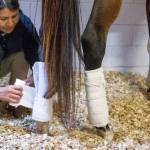Standing Up to Proud Flesh in Horses

Lower limb wounds in horses sometimes develop excessive granulation tissue during the healing process. Known as proud flesh, the cause of its proliferation remains unclear. One recently proposed theory involves an inappropriate level of inflammation associated with specialized white blood cells called mast cells.
“Despite the array of products and surgical techniques developed to remove proud flesh and to hinder regrowth, no treatment strategy to date has been found to be completely effective. Failed treatment efforts are likely because veterinarians still aren’t sure why some horses develop proud flesh and others do not,” said Kathleen Crandell, Ph.D., a Kentucky Equine Research nutritionist.
The scientists propose that low-level, chronic inflammation caused by mast cells in the wound bed may stimulate fibroproliferation or the production of scar tissue. This hypothesis was borrowed from a related condition in human medicine called keloids. As a result, the body lays down scar tissue far longer that it normally would, which grows steadily for weeks to months after the initial injury. In addition to being unsightly, excessive granulation tissue can negatively affect limb function and delay return to work.
“Mast cells secrete various inflammatory mediators, cause dilation of blood vessels in and around a healing wound, and communicate directly with fibroblasts that produce scar tissue,” Crandell explained.
If mast cells play a role in the proliferation of proud flesh of limb wounds, targeted treatments could be developed. These could include medications called mast cell stabilizers or high-quality supplemental fish oil.
“Fish oils containing omega-3 fatty acids, specifically DHA and EPA, possess natural anti-inflammatory properties and are commonly used in horses to promote healthy skin and coat,” Crandell explained.
Conflicting data currently exist regarding the role of mast cells in wound-healing and certainly warrants further consideration.
*Dubuc, V., S. Laverty, H. Richard, M. Dore, and C. Theoret. 2020. Development of a computer-based quantification method for immunohistochemically-stained tissues and its application to study mast cells in equine wound healing (proof of concept). BMC Veterinary Research 16(1):228.








